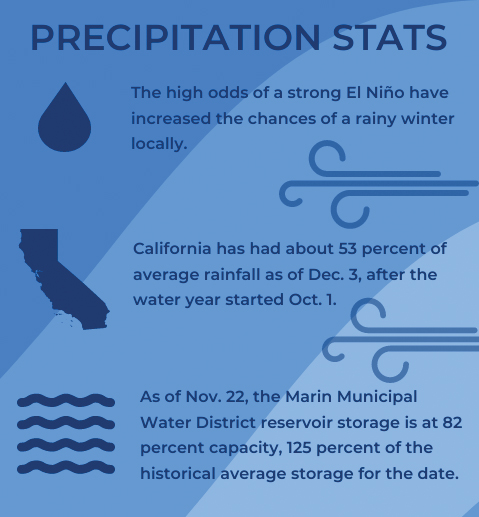Local: El Niño year for California and Marin
 The years 2023 and 2024 bring another round of El Niño and its weather implications for California and the other affected regions. El Niño is a natural phenomenon in which the Pacific trade winds – constant steady winds that blow east to west across the Pacific Ocean – switch from their normal direction and instead head east along the equator, reducing the upwelling of cold water on the coast of the Americas and resulting in warmer water temperatures. For California, this frequently translates to rainfall and stormy weather impacting areas including Marin. However, this is not always the case, as some El Niño years don’t follow this norm and end up with a drought season. This year, most forecasters, including the National Oceanic and Atmospheric Administration, predict a very wet winter and spring. Regardless, water managers must be prepared for any circumstance.
The years 2023 and 2024 bring another round of El Niño and its weather implications for California and the other affected regions. El Niño is a natural phenomenon in which the Pacific trade winds – constant steady winds that blow east to west across the Pacific Ocean – switch from their normal direction and instead head east along the equator, reducing the upwelling of cold water on the coast of the Americas and resulting in warmer water temperatures. For California, this frequently translates to rainfall and stormy weather impacting areas including Marin. However, this is not always the case, as some El Niño years don’t follow this norm and end up with a drought season. This year, most forecasters, including the National Oceanic and Atmospheric Administration, predict a very wet winter and spring. Regardless, water managers must be prepared for any circumstance.
National: Corn and airplanes, a rare combination
Air transportation significantly contributes to our warming climate. In 2021, the Biden administration came to a consensus with numerous airlines on a goal of substituting jet fuel with sustainable energy sources by 2050. This initiative has brought up discussion about the potential use of corn-based fuels to power planes. No, not full husks of corn ready to be brought to the dinner table. Instead, airlines would use corn to produce ethanol. Biofuels such as ethanol already exist to some extent in jet fuel, but airlines are considering increasing their usage. This year, United Airlines agreed to buy enough ethanol to fuel 50,000 flights a year, and other airlines are looking to do the same. A shift in this eco-friendly direction would be beneficial in decreasing greenhouse gas emissions, with the Environmental Protection Agency approximating that corn ethanol produces 20 percent less emissions than gasoline. However, as much as this “solution” seems to be golden, there are other factors that need to be considered. One major concern is the impact that increased corn production would have on water resources. The process of growing corn uses up a large amount of water and groundwater is already diminishing in many areas because of agricultural usage. Climate change causes more intense droughts and the water used in irrigation further exacerbates this issue. This situation is just another example of the compromises our country must decide on when dealing with environmental issues.
Global: Iceland or lavaland?
Not to be confused with Greenland, Iceland is widely known for its unique natural features encompassing waterfalls, glaciers, black sand beaches and more recently, its volcanic activity. On Nov. 10, the people of Grindavik, Iceland were evacuated from their homes after signs of a volcanic eruption. Earthquakes had been occurring repeatedly, and an underground stream of magma was detected underneath the fishing town heading towards the ocean, leading officials to believe an eruption was possible and ordering the 3,000 individuals to leave. While an eruption on land would cause more harm to the town, magma erupting beneath the sea is more explosive than erupting on land, which dispenses further danger.
Currently, the fault line that runs through Grindavik hasn’t caused major damage to structures; however, roads have been impaired and the sewage system has been impaired. Toxic fumes are another distresser as sulfur dioxide can lead to respiratory issues.
Although the uncertainty is concerning, there were fewer reported earthquakes towards the end of the month which gives scientists some confidence. For an additional safety precaution, two three-mile-long walls that reach 25 feet high are currently being built by the Icelandic government to redirect any magma if it happens to reach the surface.
In the meantime, the outcome remains uncertain which means the citizens of Iceland must stay ready for anything.



















